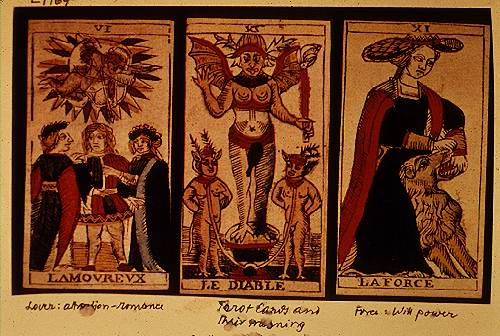

Tarot
Tarot, the name for a deck of cards mainly used for fortunetelling, and for the game played using these cards. The origin of tarot cards is uncertain; they were perhaps introduced into Europe by Crusaders between 1095 and 1270 (see Crusades) or by the Roma (Gypsies), and are known to have been in use in Italy in the early 14th century. Although the game of tarot (also called tarok) is still played in central Europe, the cards are now mainly used for fortunetelling.
A full tarot deck consists of 78 cards: the minor arcana (56 suit cards) and the major arcana, also known as trumps (22 pictorial symbol cards). The minor arcana, somewhat like a deck of modern playing cards, consist of suits of wands (clubs), cups (hearts), swords (spades), and pentacles (diamonds). Each suit contains 14 cards: 4 court cards (king, queen, knight, and page) plus cards numbered from ace to ten. The major arcana consist of a fool (also called a madman) card and pictorial cards numbered from 1 to 21.
Many of the earliest tarot decks were designed by artists, such as German artist Albrecht Dürer, who lived during the late 15th and early 16th centuries. The pictures, representing such subjects as the sun, death, the devil, and a hanged man, symbolize natural forces and human virtues and vices. Fortunes are told by interpreting the combinations formed as the cards are dealt out. Today, increasing numbers of people use tarot cards as a tool for self-exploration and personal growth.
"Tarot," Microsoft® Encarta® Online Encyclopedia 2000 http://encarta.msn.com © 1997-2000 Microsoft Corporation. All rights reserved.

Divination
Divination, practice of attempting to acquire hidden knowledge and insight into events—past, present, and future—through the direct or indirect contact of human intelligence with the supernatural. The practice was closely allied with religion among pagan, Hebrew, and early Christian peoples.
Contact with the supernatural is usually sought through a psychic medium, a person supposedly endowed with supernormal receptivity. In direct divination, the medium acquires knowledge through direct contact with the unknown. The oracle, a medium or diviner who figured prominently in the beliefs of a number of ancient peoples, including those of Babylonia and Greece, typified the mediumistic method. Oracles employed various techniques in establishing contact with divinity. Some, such as the oracle at Delphi, passed into a trance and, in this condition,uttered divine messages. Others practiced oneiromancy, or divination by dreams, and necromancy, the art of conjuring up revelations from the souls of the dead. The direct method of divination is closely approximated in much of modern spiritualism.
The accomplishment of indirect or artificial contact with the supernatural depends on the interpretation by a medium of the behavior of animals and natural phenomena, which might convey messages from the supernatural. In antiquity, common artificial or inductive means of divination were the casting of lots; haruspication, the inspection of animal entrails; and ornithomancy, the study of the activity of birds. In ancient Rome, augurs or priests performed their divination in elaborate ceremonies, called auguries, by reading auspices or omens. To determine the will of the gods, they utilized such forms of divination as haruspication, ornithomancy, and the interpretation of dreams and visions. These augurs, members of a college that existed in Rome from the founding of the city until late in the 4th century AD, exercised enormous power. No Roman would embark upon a major undertaking unless the augurs decided the auspices were favorable. The forms of inductive divination best known today include astrology; crystallomancy, or crystal gazing; bibliomancy, the interpretation of secret messages from books, especially from the Bible; numerology, the study of numbers; and the reading of palms, tea leaves, and cards.
Divination in China followed a different course. In the Shang dynasty, shoulder blades of oxen and the bottom shells of tortoises were inscribed and heated. A message was derived from the pattern of cracks formed across the inscription after heat was applied. The founder of the Zhou (Chou) dynasty is said to have established the traditional patterns of lines and added the judgments of their significance. His son, the duke of Zhou, is said to have composed the commentaries. The collected judgments are known as T'uan and the commentaries as Yao.
In the time of Confucius, additional texts, the Wings, were appended. The result was the text known as I Ching (Book of Changes). The interpretations found in the Wings are sometimes attributed to scholars of the Han dynasty.
The cosmological principle behind the I Ching is simply that of change. Change is the movement between the cosmic forces of yin and yang, as represented by the divided and undivided lines of the traditional patterns, the 8 trigrams, and the 64 hexagrams formed from them by casting lots. Three divided yin lines signify earth; three undivided yang lines signify heaven. The 64 hexagrams, therefore, represent all possible situations or changes in creation. Examination of the hexagrams will furnish a description of the universe at that particular moment in its endless process of change and will provide hints of its future course of development.
"Divination," Microsoft® Encarta® Online Encyclopedia 2000
http://encarta.msn.com © 1997-2000 Microsoft Corporation. All rights reserved.



This page was updated February 1, 2001.